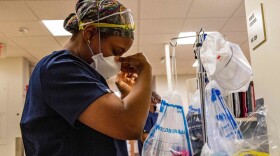
Will Stone
Will Stone is a former reporter at KUNR Public Radio.
-
When cancer survivor Katie Ripley got pneumonia, the 25-bed hospital in her small town didn't have the specialized care she needed. But with omicron surging, there was no ICU bed to transfer her to.
-
The omicron surge has clogged up the health care system, from the ICU to the ER. The consequences are huge for smaller hospitals and, in some cases, it has led to irreparable harm.
-
Slammed by COVID-19, many U.S. hospitals have put off essential procedures. Delays are leading to consequences like heart attacks and sending people to emergency rooms to get care.
-
People who get infected with omicron are less likely to go to the hospital, go on a ventilator or die. But with the current huge volume of patients, hospitals are still struggling to treat them all.
-
This latest coronavirus surge has set back a return to "normal." COVID is never going away -– and that has implications for hospitals, schools and public health officials.
-
A Seattle hospital confronts the omicron surge. While COVID-19 patients aren't as sick compared to earlier waves, there is a record number of patients overall, and not enough staff to care for them.
-
Omicron may cause milder disease, but the sheer number of patients makes this wave far worse for the health care system. With packed emergency rooms, patients can wait days to get moved to a bed.
-
In the U.S., more people are hospitalized for COVID-19 than at any other point in the pandemic. The omicron variant has slammed ERs, but doctors say this surge feels different than earlier ones.
-
There are more patients and, in some places, not enough health care workers to go around. Research shows the crowding will impact care and increase mortality for all patients.
-
Some hospitals report less strain as omicron seems to cause less severe illness. But they're still overcrowded with patients. Research shows death rates rise significantly when hospitals are full.






